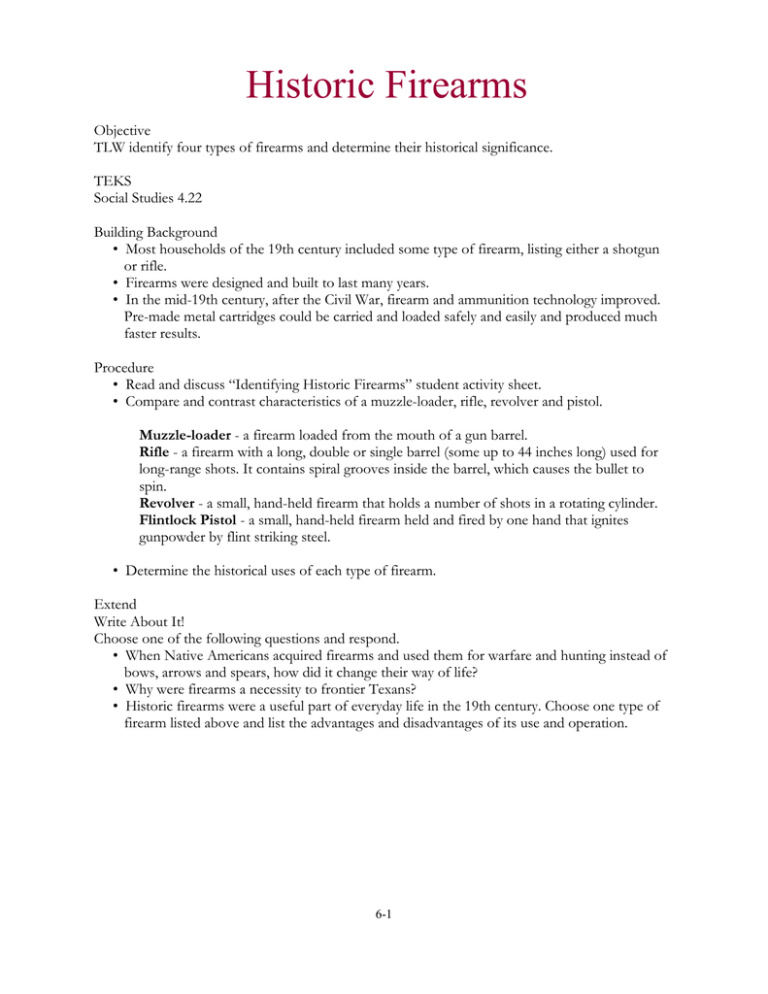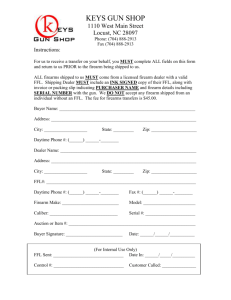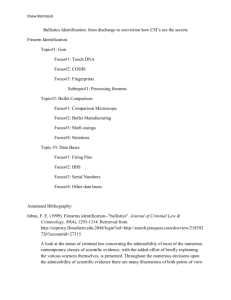Historic Firearms
advertisement

Historic Firearms Objective TLW identify four types of firearms and determine their historical significance. TEKS Social Studies 4.22 Building Background • Most households of the 19th century included some type of firearm, listing either a shotgun or rifle. • Firearms were designed and built to last many years. • In the mid-19th century, after the Civil War, firearm and ammunition technology improved. Pre-made metal cartridges could be carried and loaded safely and easily and produced much faster results. Procedure • Read and discuss “Identifying Historic Firearms” student activity sheet. • Compare and contrast characteristics of a muzzle-loader, rifle, revolver and pistol. Muzzle-loader - a firearm loaded from the mouth of a gun barrel. Rifle - a firearm with a long, double or single barrel (some up to 44 inches long) used for long-range shots. It contains spiral grooves inside the barrel, which causes the bullet to spin. Revolver - a small, hand-held firearm that holds a number of shots in a rotating cylinder. Flintlock Pistol - a small, hand-held firearm held and fired by one hand that ignites gunpowder by flint striking steel. • Determine the historical uses of each type of firearm. Extend Write About It! Choose one of the following questions and respond. • When Native Americans acquired firearms and used them for warfare and hunting instead of bows, arrows and spears, how did it change their way of life? • Why were firearms a necessity to frontier Texans? • Historic firearms were a useful part of everyday life in the 19th century. Choose one type of firearm listed above and list the advantages and disadvantages of its use and operation. 6-1 Identifying Historic Firearms Muzzle-Loaders • • • • • When the Spaniards came to the New World in the 1500s, they brought with them two important things: horses and guns. Prior to the Spaniards’ arrival, the Indians who inhabited this New World had never seen a man riding atop a horse or heard gunfire of any kind. The great stature of a man on horseback, as well as the sound of explosive gunfire, frightened the Indians. Had the Europeans arrived in the New World, armed with crossbows instead of firearms, the Indians with greater skill and precision, most likely would have slowed or stopped the Europeans’ exploration. For 350 years the operation of basic firearms changed very little: pour powder down the barrel; drop a round, lead bullet on top of the powder; jam the powder and bullet down with a rod; and strike a fire from an outside source to light the powder, which causes the powder to explode and push the bullet forward. The long rifle could only be shot one time before reloading. A good rifleman could reload, reprime and fire it again in less than one minute. ©Texas Smoke: Muzzle-Loaders on the Frontier Muzzle-loader - a firearm loaded from the mouth of a gun barrel. Rifle - a firearm with a long, double or single barrel used for long-range shots. It contains spiral grooves inside the barrel, which causes the bullet to spin. Revolver - a small, hand-held firearm that holds a number of shots in a rotating cylinder. Flintlock Pistol - a small, hand-held firearm held and fired by one hand that ignites gunpowder by flint striking steel. 6-2 Flintlock and Caplock Pistols • • • The flintlock pistol worked on the same principle as a cigarette lighter: scratch flint across a piece of steel to make enough sparks to set off the powder. Typically one in five shots would spark with no explosion. This is where the phrase “flash in the pan” comes from - the promise of making a big “bang” but only resulting in a “fizzle.” Blowing smoke out of caplock six-shooters actually had a purpose. Once the first shot was fired, a big puff of wind was blown down the barrel because some bits of unburned powder might linger in the barrel, still smoldering. The barrel needed to be clear before a fresh charge of powder was poured. ©Texas Smoke: Muzzle-Loaders on the Frontier Revolvers and Rifles After the Civil War... • • By 1865, the American frontier had moved from muzzle-loading guns to the cartridge gun. Most households of the 19th century included some type of firearm, listing either a shotgun or rifle, and were used for hunting and self-defense. ©Texas Smoke: Muzzle-Loaders on the Frontier ©Texas Smoke: Muzzle-Loaders on the Frontier Find these and other accurate illustrations of frontier muzzle-loaders by retired NASA draftsman Wesley G. Williams in Texas Smoke: Muzzle Loaders on the Frontier, by C.F. Eckhardt, copyright 2001 Texas Tech University Press. Available from Texas Tech University Press, www.ttup.ttu.edu, 1-800-832-4042. 6-3


